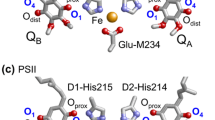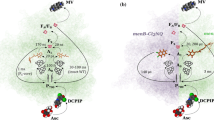Abstract
Electron transport in continuous light has been investigated in chromatophores ofRhodopseudomonas capsulata, Ala pho+, depleted in ubiquinone-10 and subsequently reconstituted with various ubiquinone homologs and analogs. In addition the restoration of electron transport in depleted chromatophores by the artificial redox compoundsN-methylphenazonium methosulfate andN,N,N′,N′-tetramethyl-p-phenylenediamine was studied. The following pattern of activities was obtained: (1) Reconstitution of cyclic photophosphorylation with ubiquinone-10 was saturated at about 40 ubiquinone molecules per reaction center. (2) Reconstitution by ubiquinone homologs was dependent on the length of the isoprenoid side chain and the amount of residual ubiquinone in the extracted chromatophores. If two or more molecules of ubiquinone-10 per reaction center were retained, all homologs with a side chain longer than two isoprene units were as active as ubiquinone-10 in reconstitution, and the double bonds in the side chain were not required. If less than two molecules per reaction center remained, an unsaturated side chain longer than five units was necessary for full activity. Plastoquinone, α-tocopherol, and naphthoquinones of the vitamin K series were relatively inactive in both cases. (3) All ubiquinone homologs, also ubiquinone-1 and -2, could be reduced equally well by the photosynthetic reaction center, as measured by light-induced proton binding in the presence of antimycin A and uncoupler. Plastoquinone was found to be a poor electron acceptor. (4) Photophosphorylation could be reconstituted byN-methylphenazonium methosulfate as well as byN,N,N′,N′-tetramethyl-p-phenylenediamine in an antimycin-insensitive way, if more than two ubiquinones per reaction center remained. These compounds were active also in more extensively extracted particles reconstituted with ubiquinone-1, which itself was inactive.
Similar content being viewed by others
Abbreviations
- UQ-n, n = 1–10:
-
ubiquinone with 1 to 10 isoprene units in the side chain
- UQ-9 sat:
-
UQ-9 with a saturated side chain
- PQ:
-
plastoquinone A
- PMS:
-
N-methylphenazonium methosulfate
- TMPD:
-
N,N,N′,N′-tetramethyl-p-phenylenediamine
- DAD:
-
diaminodurene (2,3,5,6-tetramethyl-p-phenylenediamine)
- FCCP:
-
carbonyl cyanide-p-trifluoromethoxyphenylhydrazone
- E h :
-
redox potential
- RC:
-
photosynthetic reaction center
- BChl:
-
bacteriochlorophyll
- PES:
-
N-methylphenazonium ethosulfate
References
S. Okayama, N. Yamamoto, K. Nishikawa, and T. Horio,J. Biol. Chem. 243 (1968) 2995.
N. Yamamoto, H. Hatakeyama, K. Nishikawa, and T. Horio,J. Biochem. 67 (1970) 587.
A. Baccarini-Melandri and B. A. Melandri,FEBS Lett. 80 (1977) 459.
N. G. Carr and G. Exell,Biochem. J. 96 (1965) 688.
K. Takamiya, M. Nishimura, and A. Takamiya,Plant Cell Physiol. 8 (1967) 79.
K. Takamiya and P. L. Dutton,Biochim. Biophys. Acta 546 (1979) 1.
W. W. Parson, in:The Photosynthetic Bacteria R. K. Clayton and W. R. Siström, eds., Plenum Press, New York (1978), p. 455.
J. R. Bolton, in:The Photosynthetic Bacteria R. K. Clayton and W. R. Siström, eds., Plenum Press, New York (1978), p. 419.
A. Baccarini-Melandri and D. Zannoni,J. Bioenerg. Biomemb. 10 (1978) 109.
G. Feher, M. Y. Okamura, and J. S. McElroy,Biochim. Biophys. Acta 267 (1972) 222.
R. J. Cogdell, D. C. Brune, and R. K. Clayton,FEBS Lett. 45 (1974) 344.
K. J. Kaufmann, P. L. Dutton, T. L. Netzel, J. S. Leigh, and P. M. Rentzepis,Science 188 (1975) 1301.
M. G. Rockley, M. W. Windsor, R. J. Cogdell, and W. W. Parson,Proc. Natl. Acad. Sci. USA 72 (1975) 2251.
M. Y. Okamura, R. A. Isaacson, and G. Feher,Proc. Natl. Acad. Sci. USA 72 (1975) 3491.
R. J. Cogdell, J. B. Jackson, and A. R. Crofts,J. Bioenerg. 4 (1973) 221.
K. M. Petty and P. L. Dutton,Arch. Biochem. Biophys. 172 (1976) 335.
K. M. Petty, J. B. Jackson, and P. L. Dutton,Biochim. Biophys. Acta 546 (1979) 17.
J. R. Bowyer, A. Baccarini-Melandri, B. A. Melandri, and A. R. Crofts,Z. Naturforsch. Teil C 33 (1978) 704.
C. L. Bashford, R. C. Prince, K. Takamiya, and P. L. Dutton,Biochim. Biophys. Acta 545 (1979) 223.
K. Takamiya, R. C. Prince, and P. L. Dutton, inFrontiers of Biological Energetics from Electrons to Protons P. L. Dutton, J. S. Leigh, and A. Scarpa, eds., Academic Press, New York (1978).
E. H. Evans and A. R. Crofts,Biochim. Biophys. Acta 357 (1974) 89.
R. C. Prince and P. L. Dutton,Biochim. Biophys. Acta 462 (1977) 731.
F. L. Crane,Annu. Rev. Biochem. 46 (1976) 439.
D. W. Krogmann and E. Oliviero,J. Biol. Chem. 237 (1962) 3292.
A. Baccarini-Melandri and B. A. Melandri, inMethods in Enzymology A. San Pietro, ed., Vol. 23, Academic Press, New York and London (1971), p. 556.
A. Baccarini-Melandri, B. A. Melandri, and G. Hauska,J. Bioenerg. 11 (1979) 1.
P. L. Dutton, K. M. Petty, H. S. Bonner, and S. D. Morse,Biochim. Biophys. Acta 387 (1975) 536.
R. Barr and F. C. Crane,Methods Enzymol. 23 (1971) 372.
R. K. Clayton,Biochim. Biophys. Acta 75 (1973) 312.
A. Kröger and M. Klingenberg,Eur. J. Biochem. 34 (1973) 358.
P. Mitchell,J. Theor. Biol. 62 (1976) 327.
P. Mitchell, G.R.L. 78 1–6 graits from Glynn Research Laboratories, Bodmin, Cornwall, U.K. (1978).
A. R. Crofts and J. Bowyer, inThe Proton and Calcium Pumps, G. F. Azzone, ed., Elsevier-North Holland Biomedical Press (1978), p. 55.
A. Futami, E. Hurt, and G. Hauska,Biochim. Biophys. Acta 547 (1979) 583.
G. Hauska, S. Reimer, and A. Trebst,Biochim. Biophys. Acta 357 (1974) 1.
A. Trebst and S. Reimer,Z. Naturforsch. Teil C 28 (1973) 710.
Author information
Authors and Affiliations
Rights and permissions
About this article
Cite this article
Baccarini-Melandri, A., Gabellini, N., Melandri, B.A. et al. Structural requirements of quinone coenzymes for endogenous and dye-mediated coupled electron transport in bacterial photosynthesis. J Bioenerg Biomembr 12, 95–110 (1980). https://doi.org/10.1007/BF00744677
Received:
Issue Date:
DOI: https://doi.org/10.1007/BF00744677




